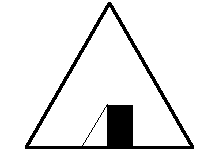 as a rational number in lowestterms. [3 marks]
as a rational number in lowestterms. [3 marks](b) If it is known that the only incorrect digit is the "8" in the next-to-last position,find the correct ISBN. [4 marks]
(a) Draw a graph that can be used to analyze this problem. Clearly indicatewhat the vertices and edges represent.
(b) Which "graph concept" corresponds to the problem that has been posed? Using graph terminology, answer thequestion. If it is possible to take a walk passing through every door exactlyonce, show how; if it is impossible, explain why.
(c) Answer the samequestion with the added restriction that the walk must end where it begins. Ifit is possible to take such a walk, show how; if it is impossible, explain whyand find the minimum number of doors that must be passed through twice in orderto accomplish this and show how. [6 marks]

(b) Usingthe nearest neighbour method starting at A, find an approximate solution to theTravelling Salesperson's Problem for this graph. Is this the optimal solution? [4 marks]

(b) Showhow the pattern can be used to explain the effect of doing (1) two reflectionsin intersecting mirrors, and (2) two reflections in parallel mirrors. [4 marks]
 Back to the Math home page
Back to the Math home page